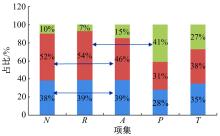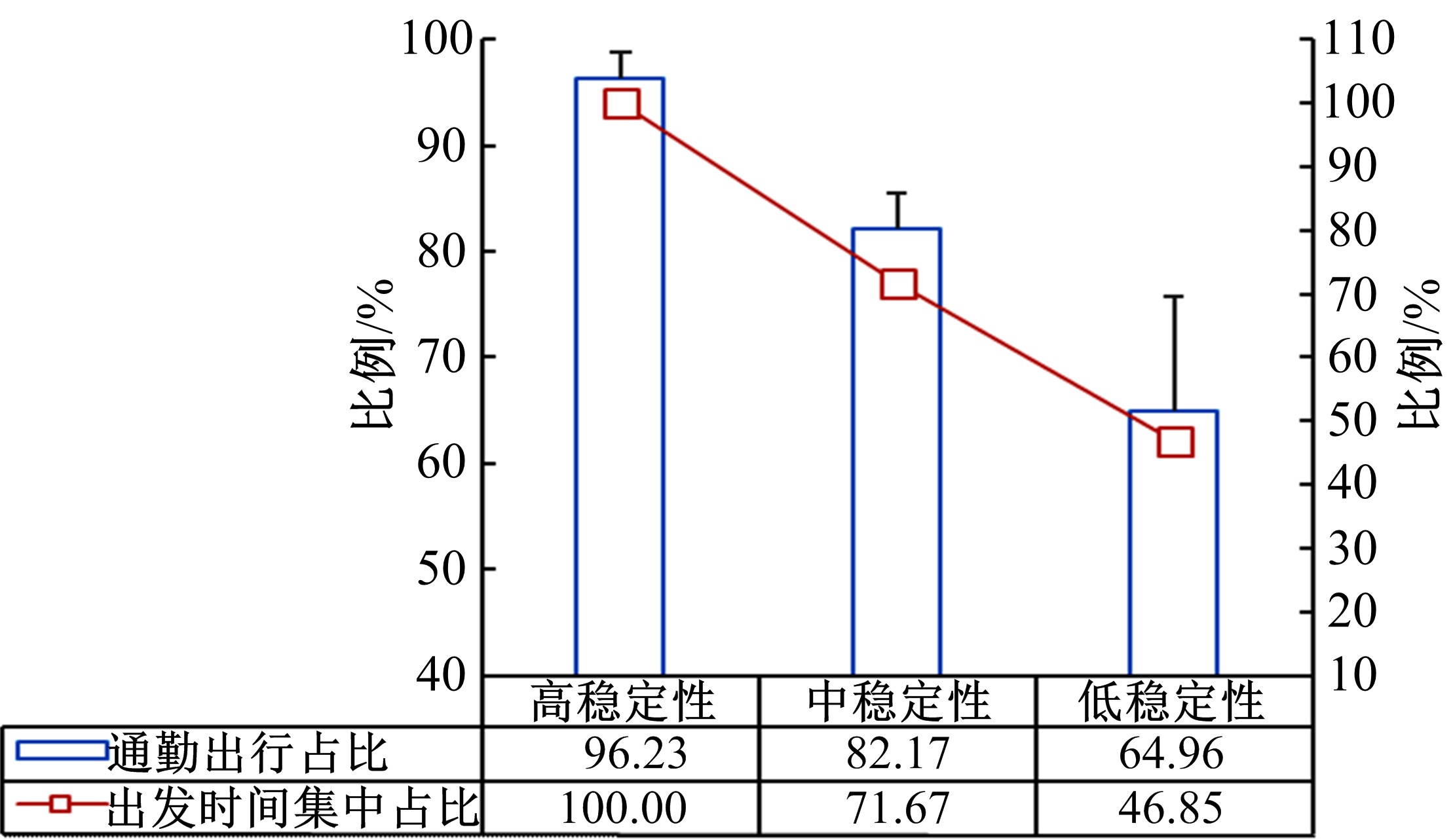Journal of Jilin University(Engineering and Technology Edition) ›› 2019, Vol. 49 ›› Issue (5): 1484-1491.doi: 10.13229/j.cnki.jdxbgxb20180351
Stability identification of public transport commute passengers based on association rules
Quan LIANG1( ),Jian-cheng WENG1(
),Jian-cheng WENG1( ),Wei ZHOU2,Jian RONG1
),Wei ZHOU2,Jian RONG1
- 1. College of Metropolitan Transportation, Beijing University of Technology, Beijing 100124, China
2. Policy Research Office, Ministry of Transport of the People’s Republic of China, Beijing 100736, China
CLC Number:
- U491.1
| 1 | 北京交通发展研究. 2016年北京市交通发展年度报告[R]. 北京: 北京交通发展研究院, 2016. |
| 2 | 翁剑成, 王昌, 王月玥, 等. 基于个体出行数据的公共交通出行链提取方法[J]. 交通运输系统工程与信息, 2017, 17(3): 67-73. |
| WengJian-cheng, WangChang, WangYue-yue, et al. Extraction method of public transit trip chains based on the individual riders' data[J]. Journal of Transportation Systems Engineering and Information Technology, 2017, 17(3): 67-73. | |
| 3 | 孙世超, 杨东援. 基于朴素贝叶斯分类器的公交通勤人群辨识方法[J]. 交通运输系统工程与信息, 2015, 15(6): 46-53. |
| SunShi-chao, YangDong-yuan. Identification of transit commuters based on naïve bayesian classifier[J]. Journal of Transportation Systems Engineering and Information Technology, 2015, 15(6): 46-53. | |
| 4 | 袁荣亮. 公共交通通勤者出行方式选择行为研究[D]. 北京: 北京工业大学城市交通学院, 2016. |
| YuanRong-liang. Research on travel mode choice behavior of public transport commuters[D]. Beijing: College of Metropolitan Transportation, Beijing University of Technology, 2016. | |
| 5 | 刘花, 陈艳艳. 北京市居民出行方式人群分类[J]. 交通标准化, 2014, 42(5): 6-11. |
| LiuHua, ChenYan-yan. Segmentation of travel mode group for Beijing residents[J]. Transportation Standardization, 2014, 42(5): 6-11. | |
| 6 | 狄迪, 杨东援. 基于人群分类的城市公交走廊客流分配模型[J]. 同济大学学报: 自然科学版, 2016, 44(2): 235-242. |
| DiDi, YangDong-yuan. A passenger-classification transportation assignment model for urban public traffic corridor[J]. Journal of Tongji University (Natural Science), 2016, 44(2): 235-242. | |
| 7 | BartD, TijsN, MarioV, et al. Examining commuting patterns using floating car data and circular statistics: exploring the use of new methods and visualizations to study travel times[J]. Journal of Transport Geography, 2015, 48: 41-51. |
| 8 | HanJ W, KamberM. Data mining: concepts and techniques[M]. San Francisco: Morgan Kaufmann, 2001. |
| 9 | 王月玥. 基于多源数据的公共交通通勤出行特征提取方法研究[D]. 北京: 北京工业大学城市交通学院, 2014. |
| WangYue-yue. Research on methods of extraction commuting trip characteristic based on public transportation multi-source data[D]. Beijing: College of Metropolitan Transportation, Beijing University of Technology, 2014. | |
| 10 | AgrawalR, ImielinskiT, SwamiA. Database mining: a performance perspective[J]. IEEE Transactions on Knowledge and Data Engineering, 1993, 5(6): 914-925. |
| 11 | AgrawalR, ImielinskiT, SwamiA. Mining association rules between sets of items in large databases[J]. ACM SIGMOD Record, 1993, 22(2): 207-216. |
| 12 | 崔研, 包志强. 关联规则挖掘综述[J]. 计算机应用研究, 2016, 33(2): 330-334. |
| CuiYan, BaoZhi-qiang. Survey of association rule mining[J]. Application Research of Computers, 2016, 33(2): 330-334. | |
| 13 | FooteP J, StuartD G, Elmore-YalchR. Exploring customer loyalty as a transit performance measure[J]. Transportation Research Record: Journal of the Transportation Research Record, 2001(1753): 93-101. |
| 14 | 曲昭伟, 姚荣涵, 王殿海. 基于最大信息熵原理的居民出行分布模型[J]. 吉林大学学报: 工学版, 2003, 33(2): 15-19. |
| QuZhao-wei, YaoRong-han, WangDian-hai. Inhabits trip distribution model based on maximum information entropy theory[J]. Journal of Jilin University (Engineering and Technology Edition), 2003, 33(2): 15-19. | |
| 15 | 王秀枝, 安建成. 基于支持度和置信度智能优化的关联分类算法[J]. 计算机应用与软件, 2013, 30(11): 184-186, 198. |
| WangXiu-zhi, AnJian-cheng. Associative classification algorithm based on intelligent optimisation of support and confidence[J]. Computer Applications and Software, 2013, 30(11): 184-186, 198. |
| [1] | Wen⁃jing WU,Run⁃chao CHEN,Hong⁃fei JIA,Qing⁃yu LUO,Di SUN. Collaborative control method of vehicles in U⁃turn zone under environment of cooperative vehicle infrastructure system [J]. Journal of Jilin University(Engineering and Technology Edition), 2019, 49(4): 1100-1106. |
| [2] | Zhao⁃wei QU,Zhao⁃tian PAN,Yong⁃heng CHEN,Peng⁃fei TAO,Di SUN. Car⁃following model with improving safety distance based on optimal velocity model [J]. Journal of Jilin University(Engineering and Technology Edition), 2019, 49(4): 1092-1099. |
| [3] | Qiao⁃wen BAI,Zhao⁃wei QU,Yong⁃heng CHEN,Shuai XIONG,Chu⁃qing TAO. Modeling on trajectories of through vehicles with an unprotected left⁃turn phase under non⁃strict priority [J]. Journal of Jilin University(Engineering and Technology Edition), 2019, 49(3): 673-679. |
| [4] | Ning⁃bo CAO,Li⁃ying ZHAO,Zhao⁃wei QU,Yong⁃heng CHEN,Qiao⁃wen BAI,Xiao⁃lei DENG. Social force model considering bi⁃direction pedestrian slipstreaming behavior [J]. Journal of Jilin University(Engineering and Technology Edition), 2019, 49(3): 688-694. |
| [5] | Lei CHEN,Jiang⁃feng WANG,Yuan⁃li GU,Xue⁃dong YAN. Multi⁃source traffic data fusion algorithm based onmind evolutionary algorithm optimization [J]. Journal of Jilin University(Engineering and Technology Edition), 2019, 49(3): 705-713. |
| [6] | Qiang TU,Lin CHENG,Fen LIN,Chao SUN. Finding shortest path considering traveler′s risk attitude [J]. Journal of Jilin University(Engineering and Technology Edition), 2019, 49(3): 720-726. |
| [7] | Chao⁃ying YIN,Chun⁃fu SHAO,Xiao⁃quan WANG. Influence of urban built environment on car commuting considering parking availability [J]. Journal of Jilin University(Engineering and Technology Edition), 2019, 49(3): 714-719. |
| [8] | CHEN Yong-heng,LIU Fang-hong,CAO Ning-bo. Analysis of conflict factors between pedestrians and channelized right turn vehicles at signalized intersections [J]. Journal of Jilin University(Engineering and Technology Edition), 2018, 48(6): 1669-1676. |
| [9] | LIU Xiang-yu, YANG Qing-fang, KUI Hai-lin. Traffic guidance cell division based on random walk algorithm [J]. Journal of Jilin University(Engineering and Technology Edition), 2018, 48(5): 1380-1386. |
| [10] | LIU Zhao-hui, WANG Chao, LYU Wen-hong, GUAN Xin. Identification of data characteristics of vehicle running status parameters by nonlinear dynamic analysis [J]. Journal of Jilin University(Engineering and Technology Edition), 2018, 48(5): 1405-1410. |
| [11] | LUAN Xin, DENG Wei, CHENG Lin, CHEN Xin-yuan. Mixed Logit model for understanding travel mode choice behavior of megalopolitan residents [J]. 吉林大学学报(工学版), 2018, 48(4): 1029-1036. |
| [12] | CHEN Yong-heng, LIU Xin-shan, XIONG Shuai, WANG Kun-wei, SHEN Yao, YANG Shao-hui. Variable speed limit control under snow and ice conditions for urban expressway in junction bottleneck area [J]. 吉林大学学报(工学版), 2018, 48(3): 677-687. |
| [13] | WANG Zhan-zhong, LU Yue, LIU Xiao-feng, ZHAO Li-ying. Improved harmony search algorithm on truck scheduling for cross docking system [J]. 吉林大学学报(工学版), 2018, 48(3): 688-693. |
| [14] | CHEN Song, LI Xian-sheng, REN Yuan-yuan. Adaptive signal control method for intersection with hook-turn buses [J]. 吉林大学学报(工学版), 2018, 48(2): 423-429. |
| [15] | SU Shu-jie, HE Lu. Transient dynamic congestion evacuation model of pedestrian at walk traffic planning crossroads [J]. 吉林大学学报(工学版), 2018, 48(2): 440-447. |
|
||







